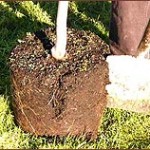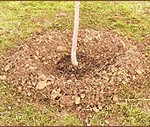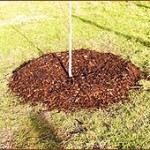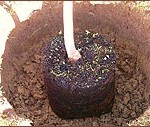Tree planting 101
The Gorge Nursery explains how to plant a tree to ensure its survival.
1. Preparation of the planting hole
Dig a hole approximately 50% larger than the root ball. Loosen the soil in the bottom of the hole, to allow for initial drainage and root penetration.
2. Root ball preparation
 Before planting a tree ensure the tree is well hydrated before planting. Do this by watering the tree several times while in its bag. If the roots are curling around the root ball of the tree or it is ‘root bound’ take a sharp spade, and cut the roots down the side of the root ball in 4-6 places (depending on the size of the root ball) and also slice across the bottom.
Before planting a tree ensure the tree is well hydrated before planting. Do this by watering the tree several times while in its bag. If the roots are curling around the root ball of the tree or it is ‘root bound’ take a sharp spade, and cut the roots down the side of the root ball in 4-6 places (depending on the size of the root ball) and also slice across the bottom.
If a mat of roots exists on the bottom this should be cut off using a sharp spade. This will help eliminate root curling and girdling and help with the regeneration of new roots in the surrounding soil.
3. Backfilling
Before adding the soil, ensure the root ball is at the correct depth, the top of the root ball should be at ground level. Place the root ball in the hole and start backfilling the root ball. With your foot firm the soil placed back in the hole. It is important to firm this soil so the root ball will not move when soaked with water. Gradually add soil and firm until the root ball is entirely covered. What comes out of the hole is what should go back in, once it has been well worked over, unless you have extreme soils ie heavy clay or very sandy. If this is the case adding some well composted material may be beneficial. No more than 30% should be used and mix it well into the remaining soil. This will help improve structure, drainage and fertility.
4. Watering

Form a concave area (or basin) with the left over soil around the top of the root ball. This will allow any water to pool around and seep directly into the roots. Water the tree after planting to ‘settle’ it in then follow advice given from our ‘Regular Watering’ guide.
5. Mulching
Forming a layer of mulch over the soil, above the roots is an excellent way to save soil moisture during h
 ot, windy periods. Form a 100mm layer of material over the roots, at least 1.5m in diameter. Do not put the mulch up against the trunk of the tree as this can rot the bark.
ot, windy periods. Form a 100mm layer of material over the roots, at least 1.5m in diameter. Do not put the mulch up against the trunk of the tree as this can rot the bark.
This not only saves soil moisture but acts as a buffer to soil temperature extremes. It also controls weeds and replenishes organic matter and nutrients in the soil. Many types of mulch can be used. These include bark waste, tree chip, and pea-straw. Make sure the bark mulch and wood chips are well composted. Saw dust and grass clippings are not recommended unless composted first.
6. Staking
If you live in a very windy location and are planting a tall tree with a lot of sail it may be beneficial to stake the tree down low to stop the root ball from rocking as this can break the new fibrous roots and slow the trees establishment.
When staking make sure you drive the stakes into the ground outside the root ball where the ground is firm. Using Hessian tree tie (or other biodegradable material) tie the tree approximately 1/3 of the trees height from ground level. Make sure the tie is not too tight as this could damage the trunk and not allow for trunk expansion. A little movement is required to stimulate calliper growth and correct trunk taper. In most cases, staking used for anchoring should be removed after 12-18 months.
7. Fertilizing
We do not recommend fertilizing your tree in the first year after planting as this can burn the roots and hinder the trees establishment. If the soil is naturally fertile there is probably little benefit in fertilizing, if however the soils are poor and your tree doesn’t look as healthy as it should (in its second growth season after planting) then an application of a broad spectrum slow release fertilizer on the surface, may be beneficial.
Reasons for tree failure
There are many circumstances out of a nursery’s control that may affect the survival of your tree once it has left the nursery. Listed below are some of the things that can have an affect on your tree:
- Planting at the wrong time of year ie. summer
- Tree drying out at any time before or after planting
- Root damage at time of planting or after planting due to movement eg. wind
- Damage during transport
- Over watering
- Poor drainage
- Use of herbicide around the tree or due to drift
- Planting in the wrong location or the wrong climate for that particular species
- Incorrect pruning or pruning at the wrong time of year
- Incorrect planting eg. too deep or too shallow
- Compaction of soil either before or after planting
- Vandalism
- Mechanical damage eg. Lawnmowers
- Wind
- Soil contamination eg. residual chemicals, toxins, salinity from tidal activity



